How to Dehydrate Potatoes
Learn how to dehydrate potatoes in easy to follow steps with photos of the process.

Also Read: How to Make Scalloped Potatoes with Dried Potatoes, How to Store Dehydrated Food, Top Tips for Dehydrating Food , How to Make Dehydrated Mashed Potatoes, Dehydrated sweet potatoes.
Why Dehydrate Potatoes?
Here are two good reasons to dehydrate potatoes:
1.Lack of Proper Storage Space
Potatoes can be stored for a long time if you have a cool, dark, dry place to store them. A root cellar is ideal. But, many of us don’t have that kind of space in our modern, warm, well insulated houses so our potatoes tend to sprout or spoil quite quickly. And you don’t want to store potatoes in the fridge because they’ll get black spots and get a weird sweet taste. So if you have lot of potatoes and no ideal storage space – dehydrating is a good option.
2.Convenient Pre-Made Meals
Dried potatoes are great for taking camping, on Air BnB vacations where you’ll have a kitchen or for making homemade scalloped or au gratin potatoes. On a busy weeknight, those dehydrated potatoes sure are fast and easy!
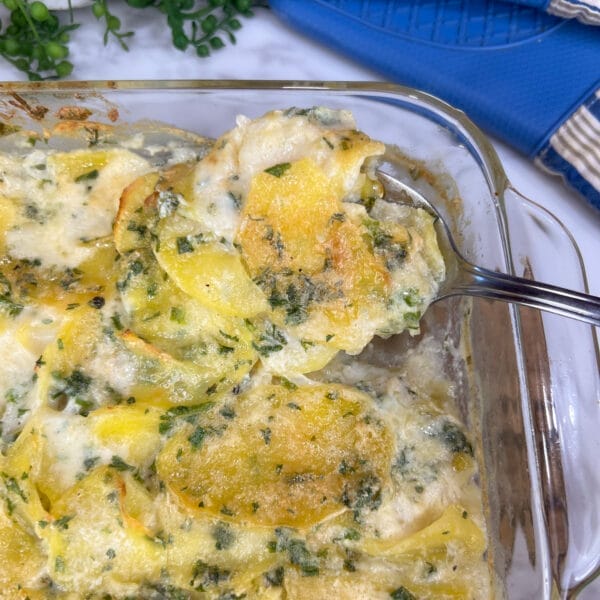
What Are the Best Types of Potatoes to Dehydrate
You can dehydrate any potato – but I prefer Yukon gold (as you can see by many of the photos), white or red potatoes. Really starchy potatoes like Russets are tricky because they can be quite crumbly when blanched so it’s more difficult to get nice sliced potatoes.
Can I Dehydrate Raw Potatoes
NO! Don’t do it, you will be very disappointed in the results. Raw potatoes will discolor badly and be completely unappealing. Blanch or par-boil potatoes before dehydrating.
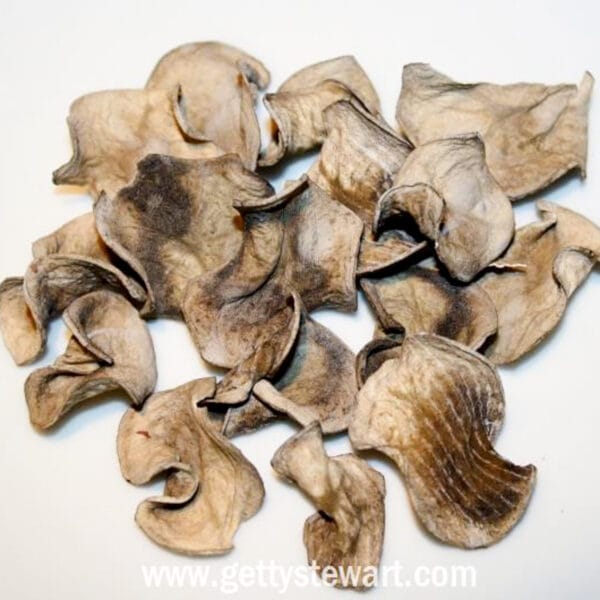
How to Dehydrate Potatoes
Step 1: Wash & Trim
Wash potatoes and cut out any blemishes. Peeling is optional, the potatoes will dehydrate equally well with or without the peel. Just be sure to remove any blemishes and to peel away any green parts – that is not edible.
Always keep potatoes in water to ensure they don’t oxidize and get discolored.

Step 2: Slice evenly
Slice potatoes to about 1/8 to 1/4 inch or 3-6 mm thick. I used the food processor, but a mandolin or sharp knife also work. Just try to keep the thickness consistent.
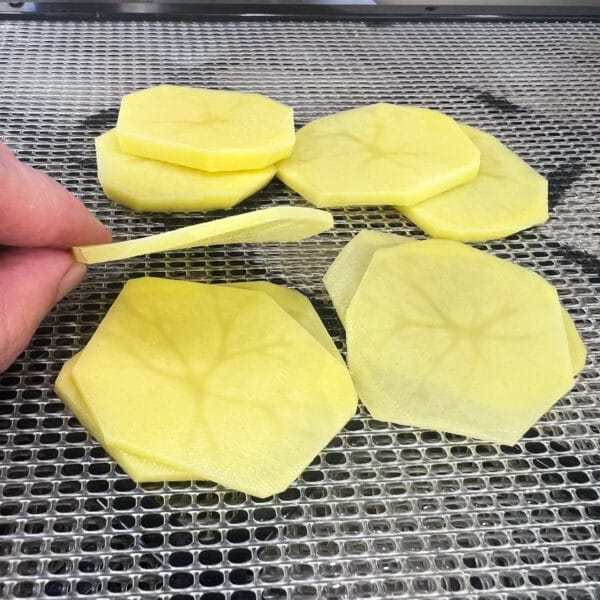
If you want, you can also make shredded dehydrated potatoes. Use the coarse shredding side of your grater.
Step 3: Blanch
Blanch potatoes before dehydrating – super important!!
Blanch the potatoes by bringing a large pot of water to boil (not salted). Add potato slices or shredded potatoes to the water and resume boiling until slices are fork tender, about 4-6 minutes. Fork tender means you can insert a fork easily without the potato crumbling.
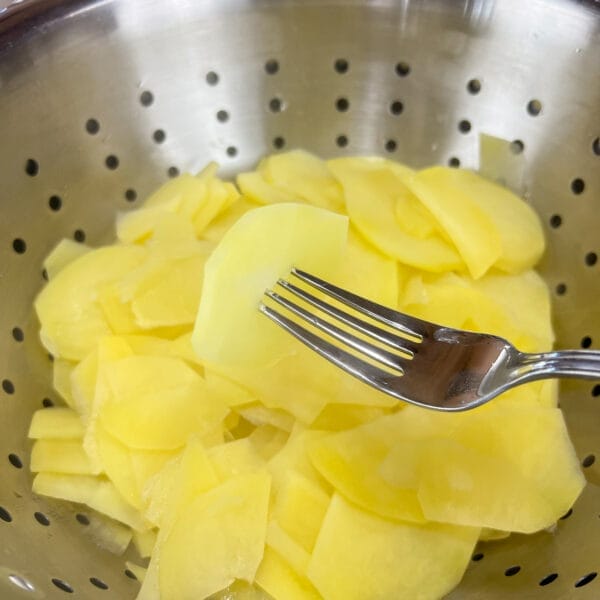
Do NOT skip this step. Seriously, the results are not pretty. Potatoes that are not blanched will turn a very unappealing grey to black colour as they dehydrate. They are not dangerous to eat – but no one will want to eat them. Look, I did a small batch just to show you.
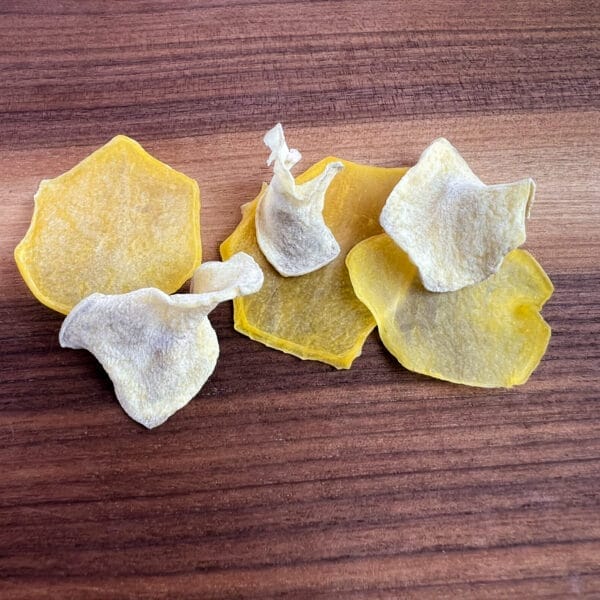
Step 4: Drain
Scoop out finished potatoe slices and drain well. Repeat the process until all potatoes are blanched.
Step 5: Spread on Dehydrator Tray
Lay slices out on dehydrator screen so they are not overlapping.
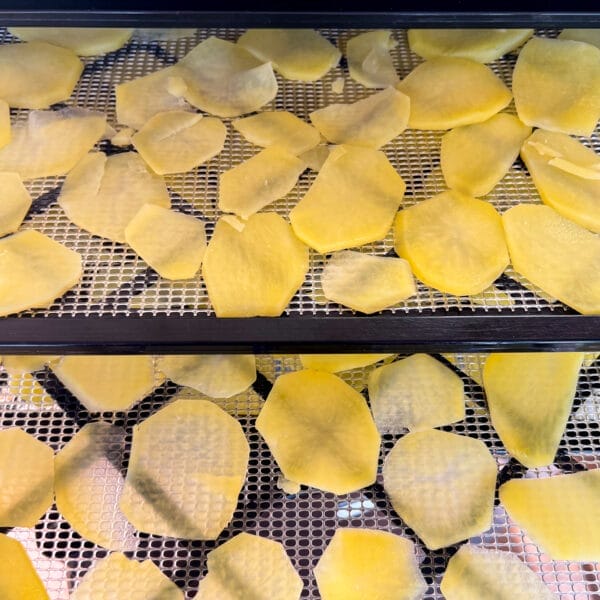
Shredded potatoes can overlap but do benefit from being tossed or stirred during the drying process.

Step 6: Dehydrate
Place in dehydrator and dry at 135° F/58° C for 6 to 8 hours for a full dehydrator. If you do a mix of shredded and sliced, be aware that the shreds may take a little less time than the slices and you may need to rotate trays or remove some before the others are completely dry.
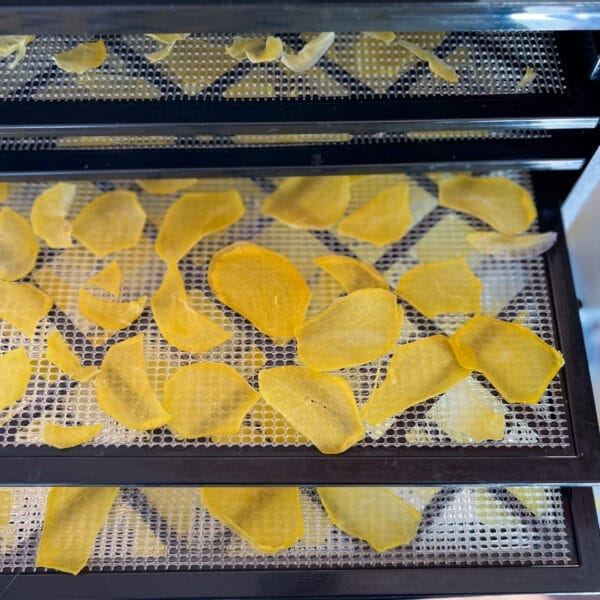
Potatoes will be translucent and crisp throughout.
Step 7: Check for Dryness
Check for drynessand rotate trays if needed. If drying shredded potatoes that are overlapping, give them a stir.
Potatoes are finished when they are translucent and crispy. They should snap in half. If they are bendable but don’t break crisply – they’re not done. They should shatter like a crsip chip when done.
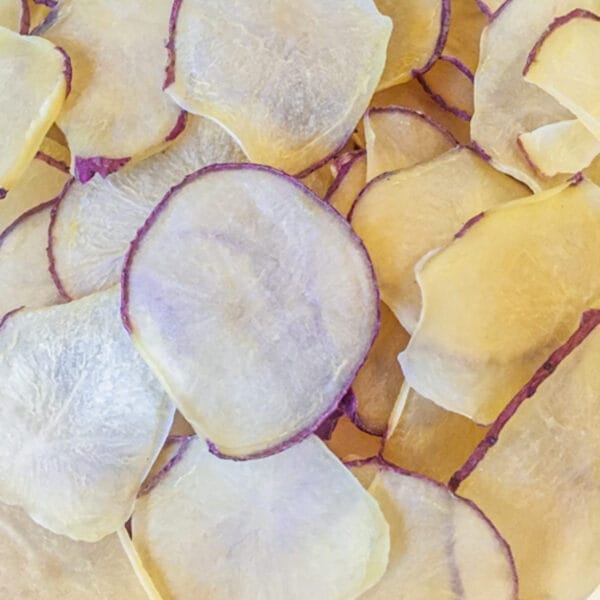
Step 8: Cool, Cure and Store
Let cool completely then store in a large container where they will not be crushed.
Keep an eye on the container for the next 7 days and watch for any signs of moisture – a change in the color of the potatoes, condensation or anything else that may hae changed. This observation period is called curing and is a good practice for all dehydrated products.
And now, you’re ready to enjoy your dehydrated potatoes.
Want more delicious dehydrated meals?
How to Re-hydrate Dehydrated Potatoes
To rehydrate dried potato slices, begin by placing the desired amount of slices in a bowl or container. Cover them with at least 1/2 inch of hot water and allow them to soak for approximately 20 to 30 minutes, or until they become soft and pliable. Alternatively, you can rehydrate them by simmering them in a pot of water on the stove for about 15 to 20 minutes. Once rehydrated, drain off any excess water and pat the slices dry with a paper towel before using them in your desired recipe.
How to Use Dehydrated Potatoes
My favorite way to use dehydrated potatoes is in scalloped potato or au gratin (cheesey scalloped potato) recipes. You can also use them in soups, casseroles or stews. You can even re-hydrate them and pan fry them.
If you have a long cooking time with plenty of liquid, you don’t need to re-hydrate the slices as shown above. This may require a little experimenting to see how much liquid the potatoes will need.
For hashbrowns, soak the shredded potatoes in water for 15 minutes, drain and pan fry.
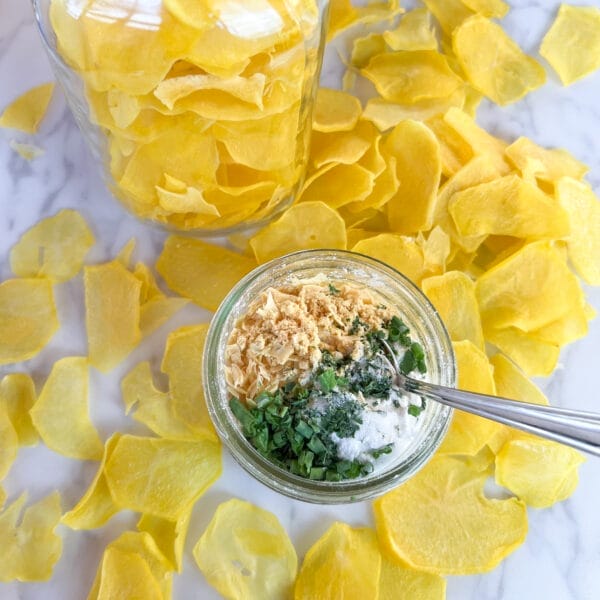
How Many Raw Potatoes Do I Need
You can dehydrate as many or as few potatoes as you’d like! But once you’re set up to do the slicing and blanching, it makes sense to at least fill your dehydrator. And, of course, every dehydrator is different – but my 9 tray square Excalibur dehydrator takes about 6-8 pounds of potatoes.
That turns into about 18-24 cups of dehydrated potato slices (rough estimate). If we assume 1/2 to 3/4 cup of dried slices = 1 serving. You’d get 35-40 servings.
Keep in mind that the actual number of servings will vary based on factors such as the thickness of the potato slices, the moisture content of the potatoes, and individual preferences for serving sizes.
Recipe for Dehydrating Potatoes
How to Dehydrate Potatoes
Ingredients
- 6-8 lbs potatoes or whatever amount
Instructions
- Wash and scrub well. Remove any blemishes and green bits. Peeling is optional.
- Always keep raw potatoes in water to prevent them from oxidizing and turning brown
- Use a food processor or mandolin to cut into even slices 1/8 to 1/4 inch thinck or 3-6 mm. Be as consistent as you can for even drying. Keep in water.
- Bring a large pot of water to boil. Add 3-4 cups of potatoes, return to boil and cook for 4-6 minutes until fork tender. (Only 2 minutes for shredded potatoes).
- Remove from water and drain. Repeat process with remaining potatoes.
- Spread evenly on mesh dehydrator tray being sure not to overlap slices. Shredded potatoes can overlap a little.
- Place in dehydrator, set to 135°F (58°C) and dry for 6-8 hours or more if you have thick sllices, a full dehydrator or live in a humid climate.
- If needed for your dehydrator, rotate trays half way through and stir shredded potatoes.
- At 5 or 6 hours check for doneness. Potatoes are done when they are translucent, crispy and shatter when snapped or broken. If they are bendy, but don't snap – they're not ready.
- Let cool completely – ideally overnight. Store in airtight containers in a cool, dry, dark place. Use within one year for best quality, although they will be safe for much longer. Vacuum seal if storing for over a year.
Video
Notes
Nutrition Facts (per serving)
Tell me, how will you use your dehydrated potatoes?
Fun fact: I first posted this article on September 17, 2013! I’ve dehydrated a lot of potatoes and other goodies since then! Updates March 2024.
Select, store and serve seasonal food for everyday cooking with Getty. Getty is a food educator and Professional Home Economist, who loves sharing tips and recipes following the seasons from her Canadian kitchen. Sign up to get seasonal tips and recipes delivered to your inbox. Learn more about Getty or check out her books and pdf guides.



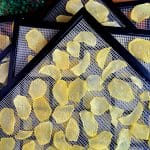
Getty,
After the blanch do you shock in ice water?
I so wanted to make a Golden Girls remark but im resisting…LOL!
Lol! Shocking in ice water is not as critical as for other vegetables, but a good idea if you think potatoes may have cooked a little too long and any more would cause them to crumble.
Dehydrating potatoes? OMG, I can’t wait to try that! Wait, that would mean it is the end of summer instead of spring. I can wait. But seriously, wonderful idea. Home made convenience food is not only for busy families. Many widowed seniors just can’t be bothered cooking for one. When one is alone, without the structure provided by another person or by work, it is all too easy to get into bad habits. I am developing ways of cooking that makes it less likely I will grab junk. The freezer is my best friend. Nice site, bookmarked.
Thanks for stopping by, so glad you enjoyed the site. You’re right, make ahead meals and homemade convenience foods are great for quick meals when cooking for one. Let me know how you’re potato dehydrating goes!
All the best for a great growing season.
Getty
Just signed up,found myself an unexpected young widow. Live in the deserts of Az. Planted my first garden full of veggies, plan to can and dehydrate.will watch your coloum, for great ideas and help with what I don’t know. K🐎
Hi Karen,
Sorry to hear of your recent loss. I hope you have many fond memories to cherish.
Hopefully you’ll find some great ideas for your newly planted garden on my site. If you have any particular questions, let me know.
All the best.Getty
Can I make mashed potatoes from these and how? Also can I do the russet and kinabecks potatoes? Not sure if I spelled it right. Would love to do this.
I have not tried making mashed potatoes. I think you would have to re-hydrate them, cook them fully and then try to mash them. Since they’re only partially cooked, I’m not sure if grinding them to powder and re-hydrating would work.
Yes, based on what other readers have said, it seems you can dehydrate any type of potatoes.
Good luck.
Gety
Quick Q. I’ve tried with marginal results dehydrating potatoes.
Are waxy or starchy ‘taters preferred?
Hi Bubba,
What does marginal results look like? What don’t you like about your results?
I have only ever used waxy potatoes. I have not tried a starchy potato like a Russet. Even blanching them without having them fall apart would be tricky.
Getty
Getty and Bubba Mustafa, I have done russet in the hashbrown shreds, I did blanch in water and salt, then rinsed twice dried with a towel for extra water then placed on my trays and let go. They dried very well, and cooked up nice.. I also used red for slices and they also can out great.
Thanks for sharing your experience, Cindi! That’s great to know.
I’m going to try this I’ve been wanting to do this for a long time now thank you for sharing
Good luck! As long as you blanch them first, I’m sure you’ll enjoy them.
Have you found that making shredded potatoes works better with russet or wax (red or gold) potatoes?
Hi DeShea,
I typically use the waxy potatoes (red) for dehydrating. Great question, not sure how the extra starch in the russets would change things.
Hello Getty. Can I dry my potatoes in a cool oven overnight as I do not have a dehydrator? I would love to be able to do this. Thanks.
Hi Dawn,
I have never tried drying potatoes in the oven, but you should be able to. Ideally, set your oven to 150°F or the lowest possible temperature your oven will go and lay your potato slices on a cooling rack so there is good air circulation. I’m not sure how long they would take at that temperature – it may take less than a full night, you might want to experiment while you’re up and about and can check on the potatoes to see how they’re doing.
Good luck.
Getty
Great presentation and valuable advices, Thank You very much.
HAve you ever combine dried potatoes with flavour like a paprika, onion, fromage..?
That sounds like a delicious combination, Ralf! Thanks for the idea.
Thanks for the great information! We usually get about 50pounds of potatoes from our garden every year so I’m always looking for new ways to store and use them. Can’t wait to do some of these!
Glad the info will come in handy, Jen.
Good luck with all your spuds.
Getty
Question after reading your page (after I dehydrated a small batch and they were black) now I blanch, but on the subject of hash browns, other pages say after blanching soak in Lemon water??? Just to make sure I will not waste another batch, is the lemon step really part of the process, I figured after blanching they were good to go. Thank you for your sharing of how to do things, a little help is always welcomed… 🙂
Hi Cindi, I have never put the blanched potatoes, shredded or otherwise in a lemon bath. I’ve not had issues with browning after blanching.
Thank you, I did 2 batches of sliced potatoes, and 1 batch of hash browns and they came out great. Next question on storing the sliced potatoes I handled however with hash browns what or how can this be done with out crushing them?
Hi Cindi,
I store them loosely in glass jars or plastic bags. As long as you don’t cram them in too tight and store them on top of other things, they’ll be fine.
Hi! what is the shelf life for these? can you vacuum seal them in a bag, or is a jar better? I am looking to do long term storage.
Thanks-
Hi Alex,
I think a good vacuum seal would be even better than a jar. I’ve kept them for a year without any issue. As long as moisture and air doesn’t get at them, I can’t see why you couldn’t store them for a long time. Quality and color may deteriorate somewhat. Hope that helps
I am not seeing any photos on this page 🙁
Thought you’d like to know
Hi David,
Thanks so much for letting me know. I have fixed the issue and you should be seeing all sorts of photos now. Enjoy!
Would like the recipe for making hash browns, au gratin or scalloped potatoes from dehydrated potatoes. Please share 🙂
Thanks for asking. So many recipes, so little time!! I’ll move these up on my list. In the meantime, one option is to add 3 cups dried potato slices to a casserole dish then pour over your favorite white sauce (search here if you want) and cook at 350 for 40 min.
I just received a 50 lb bag of potatoes and since I have been on an apple dehydrating kick I figured I bet I could dehydrate and can them as well. thanks for the tips. I too would love the recipe for scalloped potatoes because sure I am going to dehydrate some and can some whole I would like to know what to do with them once I want to use them. 🙂
Nice score on the potatoes! I better put scalloped potatoes on my schedule for November. Thanks for asking.
Thank You for the information… Shame on me for trying to dehydrate potatoes without looking for advice first… Thank You!!!
Some of us learn best with hands on experience! Hope the second batch turns out much better.
Thanks I’ve been looking for away to do potatoes.
Glad you found the information you’re looking for. Enjoy those dried potatoes!
Thanks for this! I got a great deal on potatoes and decided to slice and dehydrate them. When I checked on my first batch after about 10 min, they were looking really funky so I thought I’d check online. After reading your post, I quickly put on a pot of water and dumped them off the trays and into the hot water. They quickly lost most of the brown and are blanching now. So I’m hopeful that they’ll end up looking like your lovely dried potato slices. The rest of them will, for sure!
It’s amazing how quickly they turn if you don’t blanch them first. Glad you found the info, hopefully you were able to save them. Good luck with future batches!
Please add me to your list to get email updates from you, I cant find the form.
Hi Roxanne, the form is at the very top on the left column. If you’re on mobile, switch to desktop view to see the subscription form. Look forward to having you join the list!
I’ve been watching alot of your video’s and have’nt come acrossed Garlic yet, I just got 20 pds. of Heirloom Elephant Garlic, and this year they all came out like large onion Sets…My Question is is can I do them like potatoes ? Do I blanch them ? Or do I do as I would the onions ? Or is there a whole diffrent process with large garlic ?
Thank-you for your time sign ; Robin
Hi Robin,
Whoo eeh, that’s a lot of garlic! Happy day for you.
I have never dehydrated garlic – yet! I would dry it like I dry onions. Slice your elephant garlic about 1/8 inch thin then lay out on dehydrator mesh. Dry until brittle.
But definitely do this outside or in the garage – it will be smelly and everything around your dehydrator will absorb that garlic aroma. Not a bad thing for food, not so great on the winter coat you store in the basement next to your dehydrator! (I dried leeks next to my husband’s coat and for weeks he couldn’t figure out why he smelled so bad! Kind of funny!)
Wondering if you can use the dehydrated potatoes for American fries
Hi Donna,
I have re-hydrated my shredded potatoes and fried them, so you should be able to do the same with other cuts of potatoes as well. After soaking in water to re-hydrate you’ll want to remove as much surface moisture as possible before adding to any hot oil in a fry pan.
Good luck and let us know how it works for you.
Getty